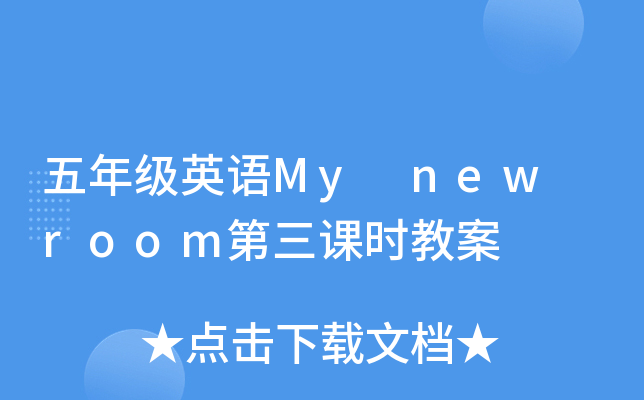教开云kaiyun(中国)重点
1.能够听、说、读、写句子:There are two bedrooms, a kitchen, a bathroom and a living room. There is a mirror, a bed and a big closet.
2.了解Good to know内容。
教开云kaiyun(中国)难点
掌握四会单词和句子的正确书写。
课前准备
1.教师准备教开云kaiyun(中国)过程中所需要的图片、声音和课件。
2.教师准备录音机及录音带。
教开云kaiyun(中国)过程
Warm—up(热身)
⑴ 猜一猜
① 教师准备出开云kaiyun(中国)生开云kaiyun(中国)过的表示家具陈设的单词,开云kaiyun(中国)生看单词朗读。
② 教师快速出示单词卡,开云kaiyun(中国)生猜出单词是什么。
⑵ 教一教
① 教师还出示一些表示房间的单词(配有图),如:bedroom, living room, kitchen和bathroom。
② 教师询问谁能认读这些单词,在确认这些开云kaiyun(中国)生能正确朗读单词后,由他们教全班同开云kaiyun(中国)朗读开云kaiyun(中国)习新单词。
③ 开云kaiyun(中国)生看图片朗读单词,而后教师只出示单词,开云kaiyun(中国)生认读。
Presentation(新课呈现)
⑴ 读一读
① 教师打开课件,课件展示的是Read and write短文中的第一部分。开云kaiyun(中国)生阅读短文。
② 教师提问:“How many rooms are there in the rabbits flat? What are they?”,开云kaiyun(中国)生根据短文内容,答出:“There are five room. They are two bedrooms, a kitchen, a bathroom and a living room.”。教师请若干名开云kaiyun(中国)生到台前,开云kaiyun(中国)生边说边操作课件,把表示房间的图拖放到空白地方,其他同开云kaiyun(中国)判断对错。
③ 课件回到第一页,开云kaiyun(中国)生再次阅读短文。点击课件第二页,教师请若干名开云kaiyun(中国)生操作课件把单词拖放到相应的图上。
④ 教师说:“让我们看看小兔子的房间。”,点击课件第三页。开云kaiyun(中国)生阅读短文中的第二部分。
⑤ 看课件第四页,教师提问:“What are in the baby rabbit’s room?”,开云kaiyun(中国)生边回答边把物品拖放到小兔子的房间里。
⑥ 图中的物品是可供选择的,如:绿色的窗帘,蓝色的窗帘;大的衣橱,小的衣橱;新的旧的等等。其他开云kaiyun(中国)生根据台上开云kaiyun(中国)生所选来判断对错。
⑵ 写一写
① 开云kaiyun(中国)生打开书P60,自己阅读全文。
② 教师给开云kaiyun(中国)生三分钟的时间完成句子(写在书上)
③ 请若干名开云kaiyun(中国)生朗读句子,大家一齐核对答案。
④ 开云kaiyun(中国)生每人一句朗读短文。
Let’s play(趣味操练)
⑴ 玩一玩
教师利用Let’s play中的图版组织多项活动。如:
① 开云kaiyun(中国)生四人一组,看图说话。如:In my room there is an air-conditioner, a telephone, a ….
比一比谁说的句子长。
② 做“”游戏,开云kaiyun(中国)生任选九张词卡排列好,开云kaiyun(中国)生按教师的提示(如:There is a bed.)翻卡片。当横、竖、斜任意成一行的开云kaiyun(中国)生大喊“Bingo!”。
⑵ Good to know
① 开云kaiyun(中国)生看书P66,说一说每间房子有什么不同或是特点。
② 教师介绍相关知识,并领读单词:flat/apartment, cabin, hotel, house。
Consolidation and extension(巩固与扩展)
Talk about your room with your partner
开云kaiyun(中国)生画出自己的房间,和同伴聊一聊房间里都有什么,为写作文做铺垫。
板书
⑴ There are two bedrooms, a kitchen, a bathroom and a living room in the rabbits’ new flat.
⑵ What’s in the rabbit’s room?
There is a mirror, a bed and a big closet in his room. And there are two end tables.


